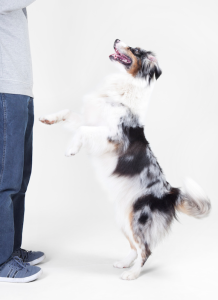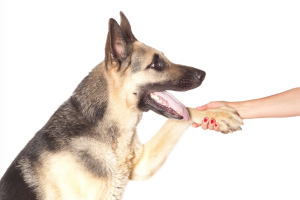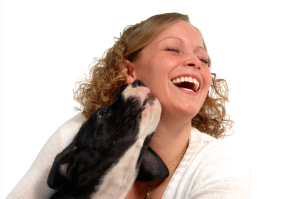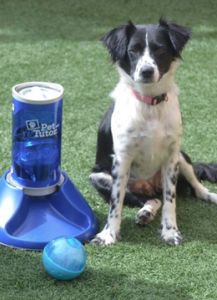 Dogs naturally want to jump on us as soon as we walk through the door. It doesn’t matter that we’re in sweat pants or dressed up for a special occasion. For Fido, that’s just how you say “Hello! I’m so happy to see you!” This is not a dominance issue, but mostly the natural expression of a dog that hasn’t learned a more appropriate way to greet humans. Muzzle licking is also how puppies greet adult dogs. It’s a polite and deferential behavior between dogs. Yet, when expressed towards people, this behavior is generally amongst the most common problems reported by owners. The older and larger the dog is, the more problematic the behavior is. What we might tolerate from a young puppy or a small dog can become truly difficult to deal with once the dog is full grown or of a large breed. As with any other behavior, any time the dog has a chance to repeat it, the behavior becomes stronger and stronger. The habit is reinforced as the neural connections are multiplying. There are many articles on the subject and different techniques to stop the bouncing hound, from kneeing the dog in the chest, to stepping on the leash or teaching an alternate behavior. But are all these techniques equally effective and efficient? How easy are they to implement? Can technology facilitate the training protocol? A couple of studies on the subject can help guide us in the right direction.
Dogs naturally want to jump on us as soon as we walk through the door. It doesn’t matter that we’re in sweat pants or dressed up for a special occasion. For Fido, that’s just how you say “Hello! I’m so happy to see you!” This is not a dominance issue, but mostly the natural expression of a dog that hasn’t learned a more appropriate way to greet humans. Muzzle licking is also how puppies greet adult dogs. It’s a polite and deferential behavior between dogs. Yet, when expressed towards people, this behavior is generally amongst the most common problems reported by owners. The older and larger the dog is, the more problematic the behavior is. What we might tolerate from a young puppy or a small dog can become truly difficult to deal with once the dog is full grown or of a large breed. As with any other behavior, any time the dog has a chance to repeat it, the behavior becomes stronger and stronger. The habit is reinforced as the neural connections are multiplying. There are many articles on the subject and different techniques to stop the bouncing hound, from kneeing the dog in the chest, to stepping on the leash or teaching an alternate behavior. But are all these techniques equally effective and efficient? How easy are they to implement? Can technology facilitate the training protocol? A couple of studies on the subject can help guide us in the right direction.
Why is the dog jumping?
Before we can start teaching the dog not to jump on our visitors, we first need to make sure she doesn’t jump on us first. If a dog is used to greeting us this way, we stand little chance that she’ll behave any different with our guests. As with any other behavior, the first line of approach is identifying what is reinforcing the dog. A dog will not jump forever unless there is something in it for him. What does the dog want? For every dog this may be a little different. Some are craving our attention after hours of being left alone, while others might be getting tactile stimulation or an object or treat you are giving them. Often too, more than one single consequence is involved in maintaining a behavior. Our natural reaction is to either meet Fido with a “How’s my baby doing?” accompanied by petting and hugging or to physically push the dog off us while shouting: “Stop!” “No!” or “Down” or both approaches depending on our mood of the moment. But either way, a look in his direction, a word or a touch, can all be considered reinforcers, contributing to the problematic behavior. In addition, our fast movements and loud voice are likely to generate more arousal in a dog that already has a hard time containing his excitement. The importance of identifying what influences our dog’s jumping was confirmed in a 2012 study (Dorey & al., 2012). Two maintaining variables were identified amongst the 3 test dogs: getting a desirable object (like a toy or a leash) and attention. All three dog showed a significant decrease in their jumping when their access to what they wanted was contingent upon not jumping for at least 20 seconds.
Rewarding the behavior we want instead
Since we tend to focus on jumping as the problem to stop, it might be tempting to try some of the popular punishing methods such as kneeing the dog in the chest or correcting the dog with a leash pop. The problem with such techniques is that any pain or discomfort experienced by the dog has the potential to be associated with you or your visitors. It’s in everybody’s best interest that the dog feels safe around people. Anxiety or fear may damage the dog’s social skills and lead to more problematic behaviors down the road. These methods alone are also missing a key ingredient for best success: they fail to teach the dog what to do instead.
Our focus should be on how we would like the dog to behave when we come home or when guests arrive. So our focus is not on discouraging Rufus from jumping, but to provide him with the opportunity to learn that jumping is a waste of energy, where sitting or lying on his bed is a rewarding experience. The very first thing to do is making sure we’re no longer contributing to the problem. A calm attitude coupled a timely delivery of our attention (and even treats) will go a long way in teaching Rufus a more polite approach to greeting people.
Teaching the dog to sit
 A dog can’t sit and jump at the same time. An easy fix to our rambunctious greeting is to teach the dog that she’ll get what he wants only when sitting down. We can ignore the dog when jumping, barking or generally showing excitement. As soon as she sits however, we’ll calmly talk to her, pet, praise and even give a treat or a favorite toy. Make sure to reward while the dog is sitting and immediately take your attention away as soon as the dog gets out of position. A good “sit” prior to applying this method will make it easier, but is not mandatory. This method has been proven to be efficient within just a few sessions (Dorey & al., 2012), thus confirming the importance of our attention to the dog. These were results obtained under very controlled situations and on a very small number of dogs. With some dogs you may have to turn your body away from the dog or even leave the room (or go out the front door) as soon as the dog jumps on you again. We can expect differences in the number of sessions needed depending on the dog and the conditions.
A dog can’t sit and jump at the same time. An easy fix to our rambunctious greeting is to teach the dog that she’ll get what he wants only when sitting down. We can ignore the dog when jumping, barking or generally showing excitement. As soon as she sits however, we’ll calmly talk to her, pet, praise and even give a treat or a favorite toy. Make sure to reward while the dog is sitting and immediately take your attention away as soon as the dog gets out of position. A good “sit” prior to applying this method will make it easier, but is not mandatory. This method has been proven to be efficient within just a few sessions (Dorey & al., 2012), thus confirming the importance of our attention to the dog. These were results obtained under very controlled situations and on a very small number of dogs. With some dogs you may have to turn your body away from the dog or even leave the room (or go out the front door) as soon as the dog jumps on you again. We can expect differences in the number of sessions needed depending on the dog and the conditions.
Once the dog reliably sits as we walk through the door, we can start working on teaching the same behavior with our visitors. But when other people are involved, things can get more complicated. Many will find excuses for the dog’s behavior and might even encourage jumping unless you prepare them in advance and ask for their help in training your dog.
When you’re expecting visitors, it’s often best to put the dog away several minutes before their arrival (so the dog doesn’t associate the visitors with being put away). After the guests are seated and the dog is calmed down, bring the dog out on leash. Ask the dog to sit before being petted by any of the visitors and reward with treats as the visitors are petting him. If for any reason you can’t deal with the dog and take care of the guests, it’s best to keep the dog in another room.
Teaching the dog to go to a bed (or place)
 Although this method requires more preparation before it can successfully be applied with guests at the door, being able to send the dog to his/her bed presents the advantage of not having to manage the dog and the guests at the same time. In this situation, the dog learns to run to his/her bed and to remain there as the visitors ring the doorbell and enter the home, until given a specific cue to get off the bed.
Although this method requires more preparation before it can successfully be applied with guests at the door, being able to send the dog to his/her bed presents the advantage of not having to manage the dog and the guests at the same time. In this situation, the dog learns to run to his/her bed and to remain there as the visitors ring the doorbell and enter the home, until given a specific cue to get off the bed.
To achieve this level of control, multiple steps are required:
- Teach the dog to go to a bed or place mat on cue. With a clicker and treat in hand, click and treat for any behavior towards the bed, like a look or a paw on the bed. Gradually increase your criteria until the dog reliably goes to the bed and lies down while you’re standing several feet away. If you’re not familiar with shaping techniques, you’ll need the help of a trainer for best results.
- Once the dog reliably goes to the bed, gradually increase the duration. You’ll want to treat every few seconds at first before gradually increasing the time the dog spends on the bed.
- Add distractions. You can gradually add distractions such as a knock on the wall or the door, running by the bed, a toss of a tennis ball, open and close the door, etc. until you can ring the doorbell while the dog remains on his bed. Keep a high rate of reinforcement at first (treats every 3-4 seconds) until you can gradually decrease to about 1 treat/minute.
- It’s time to let the visitors in. When the visitors arrive, send the dog to his bed before letting the dog in. This step is best achieved with the help of another person in the room who can reward the dog while you’re opening the door. Otherwise, you’re going to have to run back and forth between the guests and the dog.
 This protocol is much easier to implement with the help of a remote treat dispenser like the Pet Tutor® that enables us to reward the dog either manually or automatically while we move away and greet our visitors. In a study on the efficacy of using a remote treat dispenser, 15 dogs were successfully trained within 2 weeks to 4 months. Since this study included pet dogs and their owners, the training was sometimes interrupted by vacation and work and school schedules, thus increasing the overall training time. After training, the dogs no longer barked or crowded the visitors at the door. They also paid much less attention to the visitors in general (Yin & al., 2008).
This protocol is much easier to implement with the help of a remote treat dispenser like the Pet Tutor® that enables us to reward the dog either manually or automatically while we move away and greet our visitors. In a study on the efficacy of using a remote treat dispenser, 15 dogs were successfully trained within 2 weeks to 4 months. Since this study included pet dogs and their owners, the training was sometimes interrupted by vacation and work and school schedules, thus increasing the overall training time. After training, the dogs no longer barked or crowded the visitors at the door. They also paid much less attention to the visitors in general (Yin & al., 2008).
As with any training, for best results, it’s important to be consistent with the protocol. Intermittently reinforcing the jumping by occasionally giving the dog attention, will compromise our overall success. This is just an overview of a general approach. For specific details I highly recommend consulting with a professional trainer. When we take the time to teach the dog calm and polite greeting, we’re also reinforcing the dog’s ability for self control in general. Jumping is an easy behavior to treat and with a little practice, we can help Rufus go from a bouncing, mouthing and barking beast to a model dog in just a few weeks.
Jennifer Cattet Ph.D.
Training several dogs at once
Review by pro trainer


Dear Jennifer,
Thank you for citing our paper: Dorey et al., (2012). In that paper we performed functional analysis on three dogs that had a problem with jumping up. Through that analysis we found that two of those dogs’ behavior was reinforced by tangible objects (like a toy), and one was reinforced by food. None of them were reinforced by attention alone. If you’d like a copy of the paper, please don’t hesitate in contacting me.
Best,
Clive Wynne.
While first agreeing with all that Jennifer said, for many or most dogs, there may be a few dogs who so strongly want the direct attention that treats and brief petting after they sit or wait is not enough. Where a good few minutes of play, belly rubs, or such, where they’re taught to then relax when it’s over, may be the most effective reward for good behavior. While it’s not always possible, having that happen consistently and often for long enough to establish the new behavior will give them enough hope to carry over.
One former jumper would lay on his mat whenever somebody entered, then calmly roll on his back and wait so cutely that most visitors would come over. While a bouncing lady who couldn’t stay still learned to do a two-legged greeting dance (her idea, which was reinforced) to work off some energy, then sit calmly to wait for any attention.